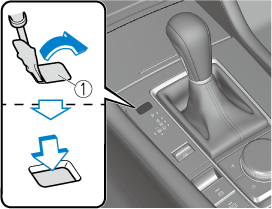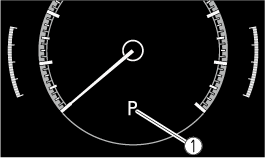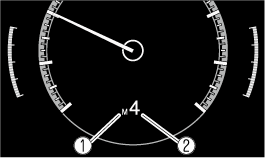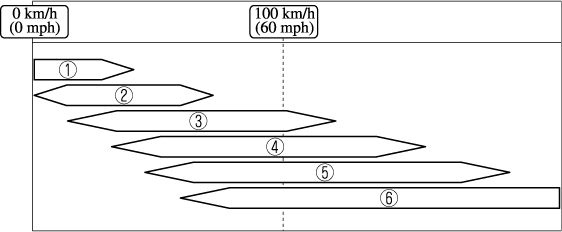Automatic Transmission
Automatic Transmission Controls
Shift-Lock Override
If the selector lever will not move from P position using the proper shift procedure, continue to hold down the brake pedal.
-
Remove the shift-lock override cover using a cloth-wrapped flat head screwdriver.
-
Insert a flat screwdriver and push it down.

-
Cover
-
-
Press and hold the lock-release button.
-
Move the selector lever.
Take the vehicle to an Authorized Mazda Dealer to have the system checked.
Transmission Ranges
Transmission Ranges
-
The shift position indication in the instrument cluster illuminates.
Refer to Shift Position Indication (Search).
-
Shift the selector lever to the P or N position to start the engine.
P (Park)
P locks the transmission and prevents the front wheels from rotating.
Always set the selector lever to P position and set the parking brake:
Only setting the selector lever to the P position without using the parking brake to hold the vehicle is dangerous. If P fails to hold, the vehicle could move and cause an accident.
-
Shifting into P, N or R while the vehicle is moving can damage your transmission.
-
Shifting into a driving gear or reverse when the engine is running faster than idle can damage the transmission.
R (Reverse)
In position R, the vehicle moves only backward. You must be at a complete stop before shifting to or from R, except under rare circumstances as explained in Rocking the Vehicle (Search).
N (Neutral)
In N, the wheels and transmission are not locked. The vehicle will roll freely even on the slightest incline unless the parking brake or brakes are on.
If the engine is running faster than idle, do not shift from N or P into a driving gear:
It's dangerous to shift from N or P into a driving gear when the engine is running faster than idle. If this is done, the vehicle could move suddenly, causing an accident or serious injury.
Do not shift into N when driving the vehicle:
Shifting into N while driving is dangerous. Engine braking cannot be applied when decelerating which could lead to an accident or serious injury.
Do not shift into N when driving the vehicle. Doing so can cause transmission damage.
Apply the parking brake or depress the brake pedal before moving the selector lever from N position to prevent the vehicle from moving unexpectedly.
D (Drive)
D is the normal driving position. From a stop, the transmission will automatically shift through a 6-gear sequence.
M (Manual)
M is the manual shift mode position. Gears can be shifted up or down by operating the selector lever.
Refer to Manual Shift Mode (Search).
Shift Position Indication

-
Shift position indication
The selector position is indicated when the ignition is switched ON.
Gear position indication
In manual shift mode, the “M” of the shift position indication illuminates and the numeral for the selected gear is displayed.
Active Adaptive Shift (AAS)
Active Adaptive Shift (AAS) automatically controls the transmission shift points to best suit the road conditions and driver input. This improves driving feel. The transmission may switch to AAS mode when driving up and down slopes, cornering, driving at high elevations, or depressing the accelerator pedal quickly while the selector lever is in the D position. Depending on the road and driving conditions/vehicle operations, gear shifting could be delayed or not occur, however, this does not indicate a problem because the AAS mode will maintain the optimum gear position.
Indications

-
Manual shift mode indication
-
Gear position indication
Manual shift mode indication
In manual shift mode, the “M” of the shift position indication in the instrument panel illuminates.
Gear position indication
The numeral for the selected gear illuminates.
-
If the gears cannot be shifted down when driving at higher speeds, the gear position indication will flash twice to signal that the gears cannot be shifted down (to protect the transmission).
-
If the automatic transmission fluid (ATF) temperature becomes too high, there is the possibility that the transmission will switch to automatic shift mode, canceling manual shift mode and turning off the gear position indication illumination. This is a normal function to protect the AT. After the ATF temperature has decreased, the gear position indication illumination turns back on and driving in manual shift mode is restored.
Second Gear Fixed Mode
When the selector lever is moved back + while the vehicle speed is about 10 km/h (6.2 mph) or less, the transmission is set in the second gear fixed mode. The gear is fixed in second while in this mode for easier acceleration from a stop and driving on slippery roads such as snow-covered roads.
If the selector lever is moved back + or forward – while in the second gear fixed mode, the mode will be canceled.
Shift Gear (Shifting) Speed Limit
For each gear position while in the manual mode, the speed limit is set as follows: When the selector lever is operated within the range of the speed limit, the gear is shifted.

-
1st
-
2nd
-
3rd
-
4th
-
5th
-
6th
Shift up
The gear does not shift up while the vehicle speed is lower than the speed limit.
Shift down
The gear does not shift down while the vehicle speed exceeds the speed limit.
If the vehicle speed exceeds the speed limit and the gear does not shift down, the gear position indication flashes 2 times to notify the driver that the gear cannot be shifted.
Kickdown
When the accelerator pedal is depressed fully while driving, the gear shifts down.
However, the transmission does not kickdown while the DSC is turned off or the Off-Road Traction Assist is operating.
Auto-shift down
The gear shifts down automatically depending on the vehicle speed during deceleration.
If the vehicle comes to a stop while in the second gear fixed mode, the gear remains in second.
Recommendations for Shifting
Upshifting
For normal acceleration and cruising, Mazda recommends these shift points:
(U.S.A. and Canada)
|
Gear |
Vehicle speed*1 |
|---|---|
|
M1 to M2 |
24 km/h (15 mph) |
|
M2 to M3 |
40 km/h (25 mph) |
|
M3 to M4 |
65 km/h (40 mph) |
|
M4 to M5 |
73 km/h (45 mph) |
|
M5 to M6 |
81 km/h (50 mph) |
-
Always observe local speed limit regulations.
Downshifting
When you must slow down in heavy traffic or on a steep upgrade, downshift before the engine starts to overwork. This gives better acceleration when you need more speed.
On a steep downgrade, downshifting helps maintain safe speed and prolongs brake life.
Direct Mode (Some Models)
Driving Tips
Driving Tips
Do not let the vehicle move in a direction opposite to the direction selected by the selector lever:
Do not let the vehicle move backward with the selector lever in a forward position, or do not let the vehicle move forward with the selector lever in the reverse position. Otherwise, the engine may stop, causing the loss of the power brake and power steering functions, and make it difficult to control the vehicle which could result in an accident.
Passing
For extra power when passing another vehicle or climbing steep grades, depress the accelerator fully. The transmission will shift to a lower gear, depending on vehicle speed.
-
The accelerator pedal may initially feel heavy as it is being depressed, then feel lighter as it is depressed further. This change in pedal force aids the engine control system in determining how much the accelerator pedal has been depressed for performing kickdown, and functions to control whether or not kickdown should be performed.
-
The manual shift mode does not switch to automatic shift mode while the DSC is turned off or the Off-Road Traction Assist is turned on when the selector lever is in the M position. Shift the selector lever.
Climbing steep grades from a stop
To climb a steep grade from a stopped position:
-
Depress the brake pedal.
-
Shift to D or M1, depending on the load weight and grade steepness.
-
Release the brake pedal while gradually accelerating.
Descending steep grades
When descending a steep grade, shift to lower gears, depending on load weight and grade steepness. Descend slowly, using the brakes only occasionally to prevent them from overheating.
















